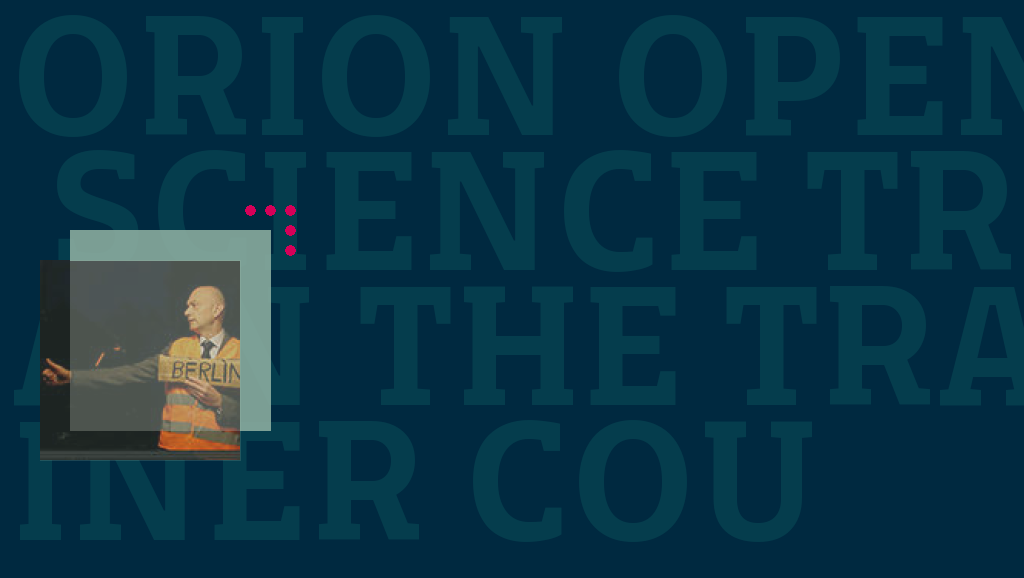Between 19 October and 4 November 2020, I attended the ORION Train the Trainer MOOC, previously publicized here on the website. The course was a follow-on from a previous ORION experience, as in October I had followed their Open Science in the Life Sciences MOOC, reviewed in detail here.
As the name suggests and the website explains:
The ORION Open Science Train-the-Trainer course is intended to guide you in how to facilitate and run training on Open Science. The course covers the theoretical underpinnings of adult education as well as practical methods and techniques to use in training events. From didactics to video creation, from audience profiles to Brainwalking. There are a range of materials, media, and activities intended to strengthen your abilities as a training facilitator, both face-to-face and online.
The course is structured into two modules: Module one is entitled Theory and covers the theory behind training adults in Open Science, including didactic concepts, identifying potential participants and their needs, defining learning aims and objectives and selecting content and design instruction. Module two is dedicated to Methods, introducing a variety of methods and materials as well as tried and tested formats and approaches.
Module One, Theory
Module one is divided into four lessons. The first deals with adult learning, and includes videos and presentations on adult education theory, raising questions about the influence of personal learning experience and offering further materials for a more in-depth look at didactics.
Lesson two is dedicated to identifying audiences and target groups and the influence of unconscious bias, and includes a rather cringeworthy video produced by Microsoft. At the time I questioned the use of this video, I found it corny and crass. But watching the BBC I saw (ex) UK political advisor Dominic Cummings in Downing Street demonstrating several of the characteristic actions presented in the video, actions that I would not have noticed had I not watched it as part of the course!
Lesson three was about defining aims and learning objectives, offering an overview of learning outcomes and an explanation of Bloom’s learning taxonomies. The lesson also contained a character activity conducted via the course forum, our space for expression and mutual learning.
The fourth and final lesson in this unit was dedicated to content and design. This module introduced the ADDIE model and its five steps to effective training and pushed the participants into thinking about the challenges we would face as we moved into training.
Module Two, Methods
The first lesson in module two (Methods) is dedicated to formats and methods, and introduces and describes the methodologies of Brainwalking, role-play, scenario questions and the generation of Individual Action Plans.
The second lesson is topically based on e-learning, with tips for adapting training for online application, improving webinars and suggestions on how to produce interesting content, organize successful online events and even how to build a MOOC.
The third and final lesson in this unit summarizes the lessons learned during the course as well as addressing problems such as maximizing learning outcomes in professional development for scientists, the importance of evaluation and transformative learning, before concluding with tips on how to develop your own methodology.
Practicalities
As I noted above, the course had a forum where the participants uploaded their activities and read those from the others. As we might imagine, this was a specialist group and there was a lot to learn from everybody else. As participants we were expected to have completed all of the tasks before our online meetings so that out time together could be best used for mutual learning and experience.
The organizers regularly put us into small groups in breakout rooms with an array of tasks, making the course interactive on an interpersonal level. This system worked very well, as a group of three can meaningfully discuss and create without exclusion or domination caused by the practicalities of the online setup.
The course was quite intensive. I dedicated at least twenty hours over the two week duration of the course to the lessons and the study materials, and several extra hours on top as each unit contained extra materials for those who wanted a more in-depth analysis of the issues addressed.
Berlin or Bust!
And then it was time to put it all into practice! The participants were asked to form groups and prepare online presentation on a range of open science topics for broadcast during the Berlin Science Week. We were encouraged to take on topics that we were unfamiliar with, and prepare a twenty-minute presentation for an Open Science Café, hosted by ORION and the Max-Delbruck-Center for Molecular Medicine.
Over several hours, the participants (alongside several other Open Science experts) presented on the history of Open Science, Citizen Science and the ‘SMOVE’ Project, Open Data and associated Fears and Challenges, Open Content and Licensing, Open Hardware, Open Source, Open Access and Science Communication.
This was great fun as well as being a wonderful opportunity to learn about a new field and try out our skills. The event was streamed and recorded and is available in its complete form here.
The course closed with an online certificate presentation and social event, and I think it is fair to say that everyone seemed to have enjoyed the entire experience. As we have come to expect with ORION, the materials and infrastructure were all of extremely high standard as were the facilitators themselves.
Congratulations to all those who prepared, presented, conducted and participated in the course, and I fully recommend it to you all when they next offer it.
Here is the video of my presentation on Open Source (below you can find the podcast):
————-
















